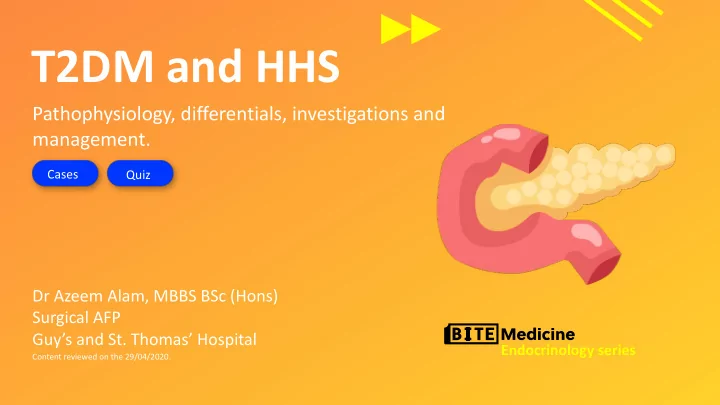

T2DM and HHS Pathophysiology, differentials, investigations and management. Cases Quiz Dr Azeem Alam, MBBS BSc (Hons) Surgical AFP Guy’s and St. Thomas’ Hospital Endocrinology series Content reviewed on the 29/04/2020.
Case 1 History A 55-year-old man presents to the GP with lethargy. He mentions that he is always thirsty and has a dry mouth despite drinking ‘gallons’ of water everyday. On examination, he has a large body habitus with a BMI of 32kg/m 2 . Observations HR 95, BP 152/65 mmHg, RR 20, SpO2 97%, Temp 37.0. 2
Case 1 History A 55-year-old man presents to the GP with lethargy. He mentions that he is always thirsty and has a dry mouth despite drinking ‘gallons’ of water everyday. On examination, he has a large body habitus with a BMI of 32kg/m 2 . Observations HR 95, BP 152/65 mmHg, RR 20, SpO2 97%, Temp 37.0. 4
Pathophysiology Pathophysiology 5
Pathophysiology 6
Pathophysiology 7
Pathophysiology Pathophysiology Definition: a metabolic disorder characterised by hyperglycaemia due to insulin resistance and relative insulin deficiency. Epidemiology 3.5 million people with T2DM in the UK • 90% of patients are adults • 80% of total cases of diabetes • Risk factors Age: 45-64 years old • Family history: strong genetic predisposition • Ethnicity • Obesity • Drugs: corticosteroids • PCOS • 9
Clinical features Pathophysiology Symptoms Signs Polyuria Neuropathy Glove and stocking sensory • loss Polydipsia Retinopathy Polyphagia Diabetic foot disease Peripheral vascular disease • Calluses • Tissue loss • Weight loss Acanthosis nigricans Fatigue 10
Clinical features Pathophysiology (1) 11
T1DM vs. T2DM Pathophysiology T1DM T2DM Frequency 10-20% 80-90% Pathogenesis Absolute insulin deficiency Insulin resistance Genetics HLA association No HLA association; strong genetic predisposition Presentation Age < 20 years old and Age > 40 years and often acute with DKA gradual onset Acute manifestation DKA Usually HHS Management Insulin Lifestyle à oral medication à insulin 12
Investigations Pathophysiology Primary investigations: • Random blood glucose: ≥ 11.1mmol/L • Fasting blood glucose: ≥ 7.0 mmol/L • Oral glucose tolerance test: ≥ 11.1mmol/L two hours after a 75g oral glucose load • HbA1c: ≥ 48 mmol/mol suggests hyperglycaemia over 3 months Investigations to consider: • U&Es: screen for renal failure • Urine albumin:creatinine ratio: screen for renal failure • Fasting lipids: screen for dyslipidaemia 13
Diagnosis 15
Management Management 17
18
Monitoring Pathophysiology Glucose HbA1c: measured every 3-6 months with a target of ≤48 mmol/mol • Self-monitoring: only advised if on insulin • Retinopathy Immediate ophthalmology referral upon diagnosis and annually thereafter • Arrange urgent review thereafter if: • Acute reduction in acuity • Pre proliferative or proliferative retinopathy • Diabetic maculopathy • Diabetic foot Should be assessed at least annually; refer urgently to foot protection service if at risk (e.g. ulceration) • Diabetic nephropathy Annual measurement of eGFR and urinary albumin:creatinine ratio • 19
Complications System Complication Pathophysiology Cardiovascular Ischaemic heart disease • Heart failure • PVD • Endocrine HHS • Neurological Stroke • Carpal tunnel syndrome • Neuropathy • Renal Diabetic nephropathy and CKD • Ophthalmology Diabetic retinopathy • Macular degeneration • Open-angle glaucoma • Cataracts • 20
Hyperosmolar hyperglycaemic state Occurs in T2DM • Higher mortality than DKA: 15-20% • Triggers : • Infection • Hypo/hyperthermia • Pancreatitis • Burns • MI/stroke • Medication: ↑ glucose, ↓ insulin or causes dehydration • 22
23
24
Diabetic ketoacidosis 25
HHS 26
Clinical features Symptoms Signs Pathophysiology Weakness and leg cramps Reduced GCS Confusion, lethargy, hallucinations Dehydration : tachycardia and hypotension Visual disturbance May be confused for a stroke (e.g. hemiparesis) Polyuria Seizures : present in up to 25% of patients Polydipsia Nausea, vomiting and abdominal pain 27
Investigations Bedside Urine dip: glycosuria • Bedside ketone and capillary glucose: hyperglycaemia without significant ketonaemia • Bloods ABG/VBG: hyperglycaemia without a metabolic acidosis • Serum osmolality: estimated using the formula = 2(Na) + urea + glucose • U&Es: electrolyte derangement and AKI due to dehydration • FBC and CRP: raised inflammatory markers may suggest underlying infection • 28
Diagnostic criteria Joint British Diabetes Societies Inpatient Care Group (2012) Hyperglycaemia : ≥ 30 mmol/L WITHOUT significant hyperketonaemia (< 3 mmol/L) WITHOUT acidosis (pH > 7.3, bicarbonate > 15 mmol/L) Osmolality : usually > 320 mosmol/kg Hypovolaemia 29
Management Fluid resuscitation: • 1 litre of normal saline within the first hour • Aim: replace 50% of fluid losses within the first 12 hours Fixed-rate insulin infusion: • Only started if ketonaemia, or if osmolality is not decreasing with fluids (0.05 U/kg/hour) • Fluid resuscitation alone is usually sufficient • American guidelines differ and state a fixed-rate infusion should be started as for DKA Other: • Serum osmolality, electrolytes, and glucose should be regularly monitored. • Rapid changes to osmolality must be avoided to prevent central pontine myelinolysis 31
Management Serum potassium concentration (mmol/L) Potassium replacement > 5.5 None 3.5-5.5 40 mmol/L < 3.5 Consider HDU/ITU for replacement via central line • Potassium: patients with HHS are potassium deplete • Anticoagulation: patients are at increased risk of VTE 32
Complications Electrolyte disturbances • Hypokalaemia and hyperkalaemia • Hypophosphataemia and hypomagnesaemia • Hypoglycaemia Central pontine myelinosis Cerebral oedema • More common in children (70-80% of diabetes-related deaths) • Likely to be iatrogenic Fluid overload Seizures 33
Top decile question 34
Further information We need your feedback and support! Release new lecture schedules every Saturday New, interactive website coming very soon Want to get involved? Contact us at opportunities@bitemedicine.com to get your information pack Stay up-to-date! • Website : www.bitemedicine.com • Facebook : https://www.facebook.com/biteemedicine • Instagram : @bitemedicine • Email : admin@bitemedicine.com 37
References 1) Madhero88 / CC BY-SA (https://creativecommons.org/licenses/by-sa/3.0). https://upload.wikimedia.org/wikipedia/commons/d/df/Acanthosis-nigricans4.jpg 2) All other images obtained from Shutterstock with permission OR self-made 38
Recommend
More recommend